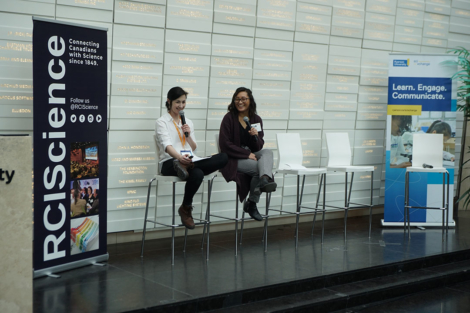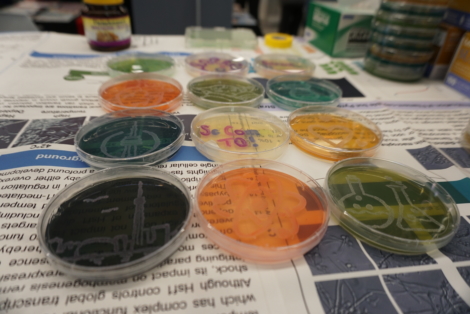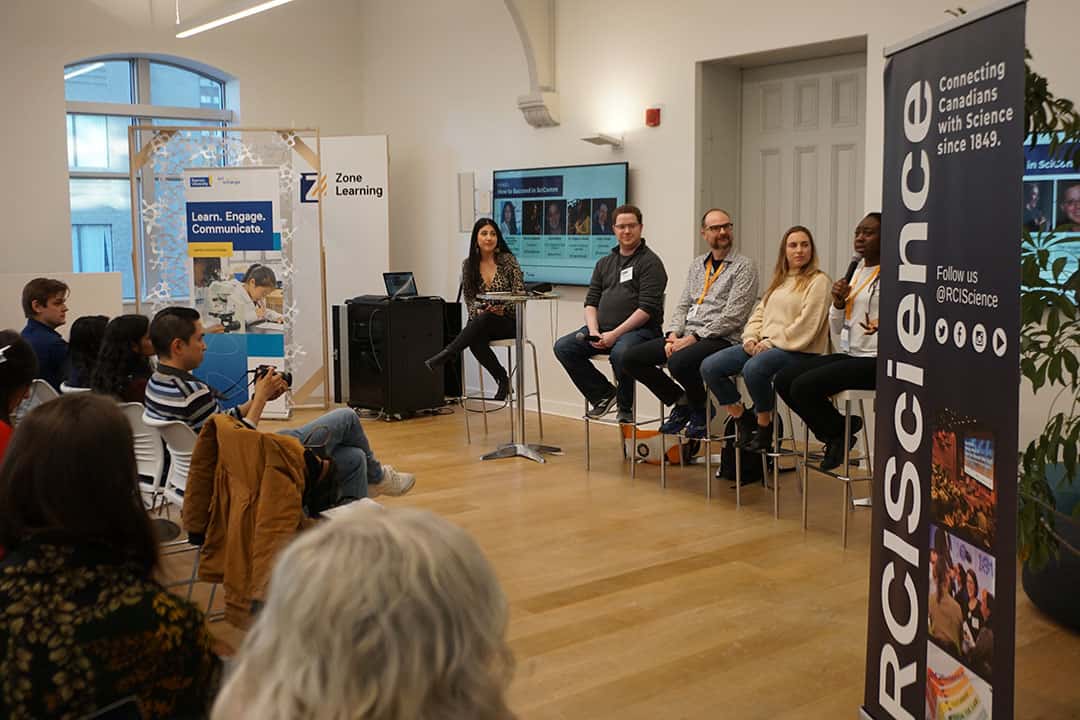Science communicators from across the GTA gathered in Toronto from February 21–22 at the first ever SciCommTO science communication conference. There, attendees gathered to discuss, argue, challenge, and debate both the state of science communication and its future direction.
The event showcased Toronto’s science communication (scicomm) network, and featured journalists, podcasters, artists, and other content creators, many of whom have ties to the University of Toronto. Highlights included panel sessions made up of various U of T alumni, workshops, and structured networking events.
What is science communication?
At its simplest, science communication is the transfer of knowledge from scientists to various stakeholders, ranging from politicians to elementary school students. Scicomm is incredibly important for translating technical science into easily understandable concepts and facts.
Effective scicomm curbs the spread of misinformation, helps people understand the value of science in society, and allows them to make informed decisions on things like health, technology, and environmental issues.
The goal of the SciCommTO conference was to unite the scicomm community within the GTA to promote an “informative and thought-provoking time, and leave full of new ideas.”
Jayden Blackwood, who has studied neuroscience at U of T and is a co-host of the Medicine in Motion podcast, was among the conference attendees. He and his team entered scicomm because the “gap between academia and practical application was not something [they] felt had been sufficiently filled,” he wrote to The Varsity.
In other words, “The research and clinical expertise we encountered were not made relatable to those outside life sciences.”
“The idea of starting a podcast was done as an outreach initiative, serving as a bridge between professional input on various health topics, and the questions/views held by everyday people wanting to learn more,” he wrote.

HAYLEY MCKAY/THE VARSITY
The importance of effective dialogue with the public
Conference attendees could join one of three breakout sessions that occurred simultaneously on the first day, all with the theme of both understanding and challenging the means by which we communicate science.
Anthony Morgan, founder of Science Everywhere, explained that “trying to address misinformation by providing the public with well-sourced, accurate information seems like a losing battle.”
Morgan believes that this should not be the only strategy. Rather, “Our goal as science communicators ought to be to foster the kinds of cultural values that really help reinforce good critical thinking,” he continued. “A really good strategy… is [to] talk to people who see things differently than you… If we collectively do that, then we will reduce the amount of misinformation that spreads because we’re always wondering… how will someone who sees things differently interpret this?”
Succeeding in scicomm
Following the breakout sessions, participants reconvened for a panel on succeeding in scicomm. A significant highlight of the speakers’ advice was to leverage your skills into paid roles and negotiate compensation for work assignments before accepting them. Another highlight was to consider discussing long-term career plans with an employer, asking: “What can you do for me?” This can enable you to work with the employer to alter the responsibilities of the job to help with your long-term career plans, which can motivate you to do a better job with your work.
Dr. Samantha Yammine, popularly known as “Science Sam,” suggested that you should “make the negotiation about more than money.” She passed on the advice of the three Ps: passion, prestige, and payment.
“You should be getting two out of those three for anything that you agree to,” she said.
Additionally, the nature of your career could be drastically different depending on your choices. Many science communicators are freelancers who work on a contractual basis rather than in traditional full-time positions. While this provides flexibility, the panelists noted that the ebb and flow of employment opportunities and the difficulty of landing enough assignments to pay a living wage are barriers to consider.
Celia Du, a freelance science communicator and filmmaker, spoke to The Varsity about her transition into freelance scicomm. “I did not see myself as a freelancer,” she said, reflecting on the start of her career. “I was applying to jobs… and I did a lot of cold-call emailing, reaching out to a lot of organizations.”
The organizations that responded to her offered volunteer opportunities. She chose to volunteer for two of them, and leveraged those experiences to build her network — a process she highlights as a turning point in her career.
“But then, once people see you and hear your perspective, see what you’ve done for scicomm, they start to want you to do more for them.” This led Du to work for a multitude of organizations, such as the Royal Canadian Institute of Science and the Royal Astronomical Society of Canada Toronto Centre.

HAYLEY MCKAY/THE VARSITY
Practical tips for writing headlines and asking questions
Jon Farrow from the Canadian Institute for Advanced Research led workshops on the second day, focusing on the essential arts of writing headlines and asking questions.
He shared insights and tips on how to draw in a reader: the first step is to do your research by knowing your audience, and engaging them from the get-go. Farrow suggests using language to create intrigue. Evocative words and puns can go a long way — so long as the puns aren’t too niche! Another useful tip noted the power of listicles: many people like to organize and compartmentalize information into lists, so headlines mentioning listicles are especially engaging.
In a workshop on improving interviewing skills, Farrow and his co-leader Cynthia MacDonald, a career science writer, went through basic tips that any interviewer should remember. A key tip is to do your research; you should come prepared with questions, according to Farrow and MacDonald. The questions don’t have to be complex — in fact, they shouldn’t be.
The best interviewers ask straightforward questions that elicit thoughtful responses, rather than brief responses of yes or no. You can also refer to what Farrow and MacDonald call the GROSS questions if you find yourself unprepared for a last-minute interview: goals, reasons, obstacles, solutions, and starts.
Leveraging creative storytelling for scicomm
University of Toronto alumni Dr. Cylita Guy and Dr. Krishana Sankar kicked off another workshop by going through some background and theories of creative storytelling, beginning with the simple question: why tell stories? Storytelling is fundamental to human experience — we have been telling stories to disseminate information for millennia.
The use of metaphors, which are commonplace in storytelling, can engage an audience much more quickly than straight facts and figures, because they tap into our senses and emotions, they noted. When a story is relatable or evocative, it can persuade listeners to take action, which is exactly what science communicators want their audience to do.
So how do you incorporate storytelling into science communication? Like before, you need to know your audience. This is important so you can tailor your narrative, use references your audience is likely to understand, and make sure you avoid any jargon that wouldn’t be common knowledge, according to Guy and Sankar.
Next, you must create your narrative, they continued. This involves creating characters and settings, which are the people and places involved in the scientific topic you are exploring. You also need to set a tone for your story, they noted. It is important to have a central theme in mind — the main takeaway or lesson of your narrative — before you begin.
Some other tips they shared for incorporating storytelling into scicomm included using graphic imagery to help set the tone. They also recommended talking about failure. While it might seem counterintuitive, it humanizes the subject.
Many scientific narratives don’t have a nice conclusion that can be wrapped up in a bow, they added, so leaving a story open-ended is absolutely fine.
The future of scicomm
People interested in scicomm as a career often face challenges breaking into the field. A common challenge faced by science communicators, explained Sankar, is finding validation and recognition for your work. Sankar wants more people to recognize that scicomm is “a necessary skill — it’s valuable.”
To help educate people on the importance of scicomm, Sankar would like to see “universities… such as the University of Toronto actually having courses for students [to] develop [their] science communication skills.” Science communicators, especially those who are graduate students, face challenges pursuing their work because “people, especially academics… do not see the value of their students going out and learning these skills.”
“Instead they think this is taking away time from their research, but it’s actually complementary,” she said. Guy adamantly agreed, reflecting, “I had to fight tooth and nail to justify what I was doing.”
The issue of pay was also discussed at length during the conference. Relating it to the issue of validation and acknowledgement, Sankar observed, “A lot of organizations do not want to pay, because I think there was a precedent set that [scicomm work] was being done on a voluntary basis.”
In an effort to open people’s minds, Guy believes that unapologetically sharing your work in scicomm is key. She advocated for normalizing scicomm as a career field, and responding to skeptics with the attitude of, “I don’t care what you think!”
“[Scicomm is] valuable — we should talk about it like we talk about our science.”


